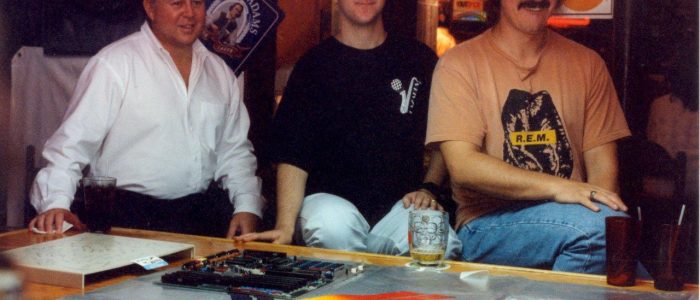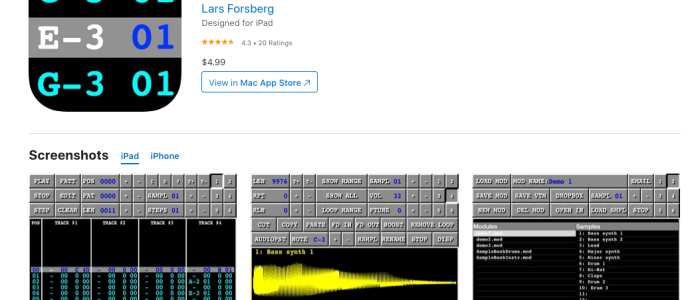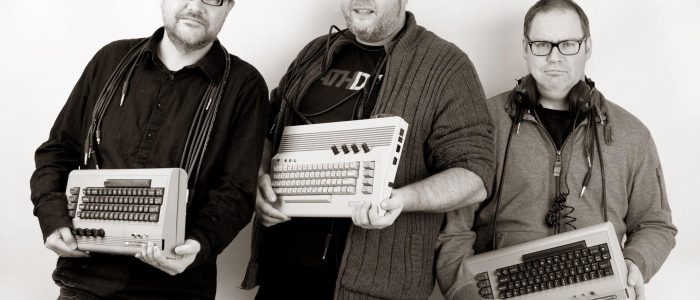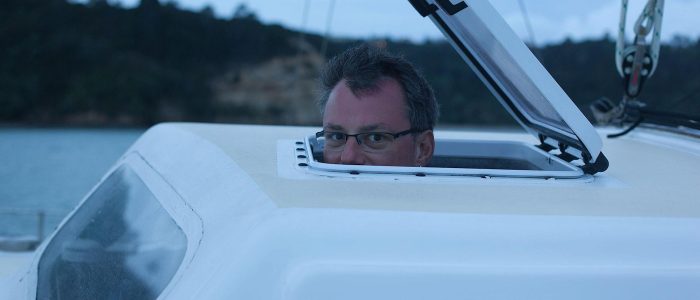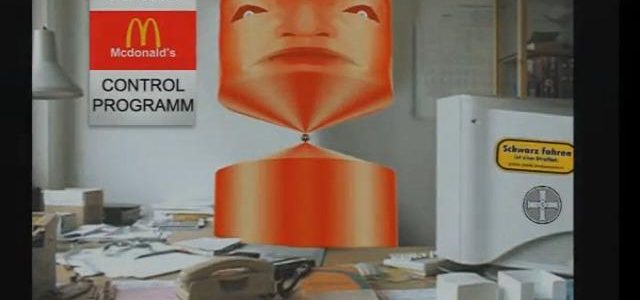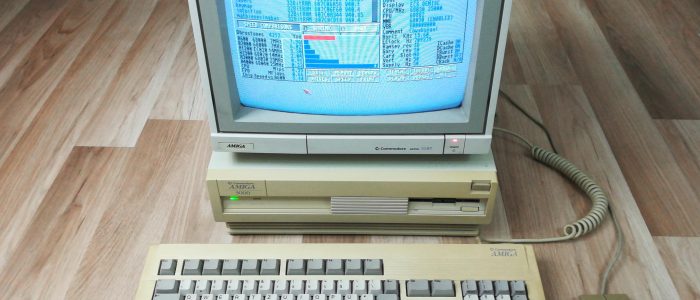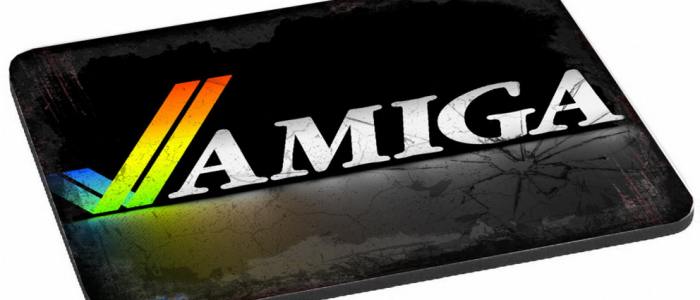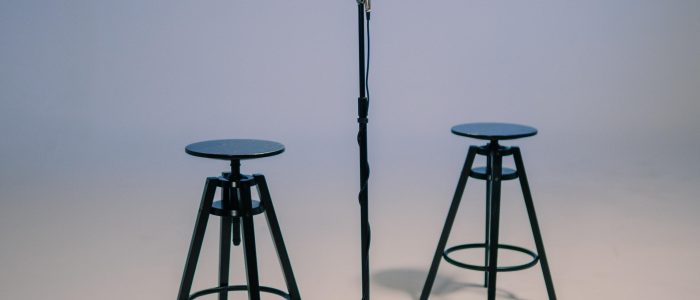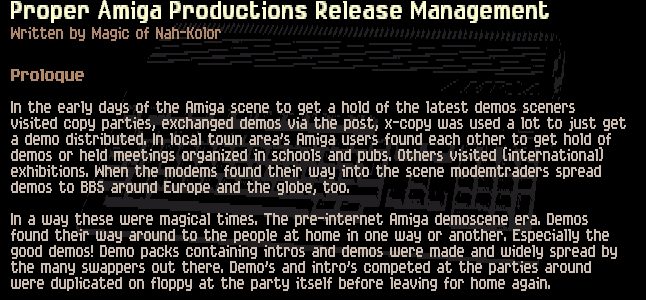In this massive interview we talk to Alfred Faust, the man behind BarsnPipes about this popular Amiga sequencer and his plans for the future.
BarsnPipes and Alfred Faust
interviewed by Psychreator/Moods Plateau
In this massive interview Psychreator/mds talks to the man behind BarsnPipes about this popular Amiga sequencer and his plans for the future.
Psychreator: Hi Alfred, first of all, please tell our readers something about yourself.
Alfred: Oh, what shall I say … I’m now 53 years old and already a pensioner. I’m married, and we have 4 children, 3 sons and 1 daughter. The youngest, the daughter, is now 23 years old. Nearly 10 years ago, the doctors diagnosed that I have a hard incureable illnes, called „Myastenia gravis“ (weak muscles). This was the reason, why I couldn’t continue to work in my profession as a parson in the „Evangelish Lutherian Church in Thuringia“. Before I became a pastor in 1982, I worked as a church musician at some places in Thuringia.
That I became ill was luck for the users of Bars&Pipes … ;-)
I found a new „job“, as Todor Fay in December 2000, exactly at my birthday, released the source code of Bars&Pipes Professional: further development of Bars&Pipes.
Psychreator: Have you ever heard of the Amiga Demoscene, have you been active and how do you like the Demoscene in general?
Alfred: My oldest son was the first one to show me some Amiga Demos. He purchased his own computer (AMIGA 1200) in 1994. Short after he got his own AMIGA, he started programmming for AMIGA-OS, mostly in E but also in assembler. Soon, he tried to do some small demos, not very big but nice. I myself have not had the time to do something similar. But I was very interested, also because of the (at that time) fantastic sound possibilities of the AMIGA. It’s very impressive, what „our best girlfriend“ is able to show. I’m not active in the AMIGA Demoscene, but I like it.
Alfred loves Nexus7 from Andromeda
Psychreator: Do you have a favorite Amiga Demoscene production?
Alfred: Sorry, no. But exactly in these days, I have had a look again at my CD-collection from the „good old days“ (for example the CU-AMIGA Magazine series). It’s real fun for me to see and hear, what nice and good things had been created at that time. Example: Nexus7 by Andromeda. Uploaded to Aminet by Philipp Teschner. Nearly 5 minutes great sound and graphics… size ~800kB… fits on a DD-disk.
Psychreator: What kind of computer systems do you use today and what was your first computer ever?
Alfred: In my small computer room I work with:
– an AMIGA 1200 / Blizzard 1230-50 / 32 MB / 3.4 GB HD / CD-ROM
– a PEGASOS / MorphOS / 256 MB RAM / 6.4 GB HD / CD – ROM / Soundblaster LIVE! – soundcard
– a microA1 / OS4 / 256 MB RAM / 20 GB HD / CD – ROM / Soundblaster LIVE! – soundcard
– a Sempron 3000+ machine / SuSE LINUX 10.2 / Windows 2000
You may think,… what a rich man… four different computers…
The first 3 computers in this lists are all gifts. An AMIGA1200 is from my oldest son. The PEGASOS was sponsored by AHT Europe, Birmingham, UK. And the microA1 was sponsored by Hyperion Entertainment – Belgium. The sponsored machines are „connected“ with the job, to port BarsnPipes to MorphOS and OS4. My very frist computer was an AMIGA 500 – purchased in 1991, wich I had upgraded (for much money) with an accelerator and HD and CDRom. Later I built it into a tower. Unfortunately it does not work anymore. Maybe I will reactivate it sometime.
I have also had a towered A1200 with a ZorroII board, MerlinII-gfx-card and Prelude-soundcard and MultifaceIII I/O-card with 68040/40 BizzardIV accelerator. Unfortunately it broke some weeks ago. With big efforts I could rescue my whole programming data. The HD from this computer now works in the A1200/68030. Unfortunately I haven’t got much money available as a pensioner. So I can’t buy a new motherboard for my towered A1200. The other one has no working serial port, no MIDI available, no further development on BarsnPipes (at the moment) for classic AMIGA OS.
Coding on an Amiga is more fun
Psychreator: Why do you like coding on Amiga instead of coding for other plattform like PC or Consoles?
Alfred: I’ve tried to program for Windows, AROS and JAVA in the past. But programming for AMIGA is really more fun. It’s much easier to reach the target on AMIGA. With JAVA it is also relatively easy to program, but it is much more complex and it’s purely object oriented. I’ve also made an attempt to write a JAVA version of BarsnPipes. Because Java is object oriented, BnP must be written from scratch, so I only can make very small steps.
Sure, I have the blueprint of a fantastic program, but all must be written again. AROS is similar, like AMIGA-OS, but its a bit harder to code for it. AROS is not the same, like AMIGA-OS. My attempt to port BarsnPipes to AROS couldn’t be finalized yet. AMIGA’s API (Application Programming Interface) is simple (compared to the other platforms‘ API’s). The base programming language is C with any possibilities for assembler. There are many other programming languages available for AMIGA. Unfortunately they are not useable for my purposes. But nevertheless, programming isn’t an easy job in general.
Developer taken over by Microsoft
Psychreator: Now we want to hear from you something about your main project called Bars N’Pipes. What is this software good for and how does it work?
Alfred: Where to begin? First of all: I’m NOT the inventor of BarsnPipes. BarsnPipes is the „child“ of Todor Fay and his wife Melissa Jordan Gray, who founded the Blue Ribbon Inc. in 1988 (!). Some words about Blue Ribbon Inc.: After Commodore went became insolvent and the AMIGA market got more and more unimportant, this software company had to take a hard decision for its own future. In 1996 they were overtaken by Microsoft Inc. There they worked on the „Music machines“-project. They also invented the Direct Audio, which was later further developed to the well known DirectX.
In 1998 some english friends asked Microsoft Inc. for the source-code of „Bars&Pipes Professional 2.5b“ (this was the official name of the last release, which was given away as FREEWARE – not Public Domain). The answer from Microsoft Inc.: ‚Yes, you can get the source-code for 1.000.000 US$‘. In other words „NO!“. Nobody could invest such a big amount of money in a niche project of a niche computer-system. In November 2000, however, Todor Fay surprised the Bars&Pipes community with the announcement to release the sourcecode of Bars&Pipes Pro. He was looking for some programmers who would be willing to prepare the material for an official release for the public. I was one of the lucky eight who received the source – worth 1 million US$.
1 Million USD for the source code of BarsnPipes Pro?
Shortly after that, a discussion between those programmers who had received the source-code came up on the question of how to make a general project. No solution could be found regarding the central storing place and the leader of the project. Because I was very curious whether the material could be compiled to a running B&P, I started a development direction on my own.
First of all, I had a closer look at the material that I had received. So I could recognize that this was the source of Bars&Pipes Pro 2.5c beta, a never released version. Also, the material was incomplete and not bugfree. I started to prepare the source during christmas in 2000. Later, I could compile the source for the first time to a running program… with many bugs and incomplete. This first preparatory work was very hard and took much time. At the end of May 2001, I could finalize this first step. The source of the main program and the sources of some tools and accessories (the plugins of B&P), which had also been given us, were in a complete and compileable state.
Todor Fay had given me his „OK“ to take this material as the official release of the source-code of „Bars&Pipes Professional 2.5c beta“ to public. It is downloadable from my homepage: www. alfred-j-faust .de
Immediately after that I started to create my own further developing project (line) in order to show that
a) this is the further developed Bars&Pipes Pro
b) this is a own developing line
I decided to give the program the name: „BarsnPipes New“.
What, please, is BarsnPipes good for ? BarsnPipes is simply the best Multimedia MIDI sequencer program, which was ever made for a computer… yes… really… I seriously browsed the software market for a MIDI-sequencer, which has a similar functionality and is similarly easy to handle and similarly expandable through a plugin-surface like BarsnPipes… I couldn’t find a single one. Sure, there are other great musicial programs with MIDI-possibilities, but none has the possibilities of BarsnPipes. Example: only BarsnPipes can record on all 16 MIDI-channels at the same time simultaneously.
What’s MIDI?
In the time, as computers were big monsters, with no music-capabilities, electronic music instruments were already on the market. The engineers searched for a possibility to play an instrument from another one. The „Musical Instrument Digital Interface“ was born. Over a 2 wire cable only very short commands are transmitted like:
– Note c3 on, Note c3 off (the note command also contains the velocity – a value for the loudness of a tone).
– choosing a sound on the other instrument a so called „Program change message“
– There are some other MIDI commands, to change other values of a sound, like the place in the stereo-panorama, the base volume of instrument. These are: „Controller change Messages“
– There are many other kinds of MIDI messages.
MIDI works on 16 different channels, meaning 16 different instruments can be controlled by MIDI simultaneously. The most important disadvantage of MIDI-transmission: it is a serial transmission protocol – one after another. So it is technically not possible to send for example two NoteOn-commands at the same time. MIDI makes use of the fact that the human ear can’t recognize small latencies (like the human eyes can’t see single pictures, if they are changed fast – like in cinema). You can’t hear 3 or 5 milliseconds time shift as a delay, you hear this as if it was simulteneous.
When the personal computers came up (AMIGA was one of these new computers), MIDI also could be controlled by them. Now it was possible not only to control MIDI-instruments, but also to record and manipulate the recorded MIDI-data. Exactly for this purpose Bars&Pipes was made. There are some other good MIDI-sequencers made for AMIGA (ex. „MusicX“ by Talin), but only Bars&Pipes has the genious plugin-system, by which the capabilities of B&P can be expanded almost without limits.
If a new function shall be added to B&P… tell it a programmer (who hopefully is a musician, too), and he can write a tool or an accessory.
The user-interface of BarsnPipes is constructed as intuitive as possible – for musicians who are mostly not computerfreaks. Any of the serious musicians, who are still using BarsnPipes, won’t ever want to miss it. BarsnPipes is handy for beginners and also very suitable for professionals.
One program for three computers
Psychreator:You develop Bars N‘ Pipes for three different platforms, Amiga 68k, Amiga PPC with OS4 and MorphOS. What is the main difference between the 3 versions?
Alfred: Like you know, the AMIGA has additional chips onboard, which are working together with the CPU, called custom-chips. These custom chips are not available on the PEGASOS (MorphOS) and AmigaOne – microA1 (OS4). So I had to write all internal routines again, which are using the custom chips. Or I had to adapt them.
One of the most important thing: The „timer-heart-beat-generator“ of BarsnPipes on the AMIGA is using the PAULA-chip. For OS4 and also for MorphOS I’ve written new timer routines. BarsnPipes is one of the rare programs on AMIGA, which have a drag&drop function since its first release. This function is using the so called „Blitter“. I have also written it again.
On MorphOS I made a toolset for a special USB-MIDI-Interface first. On OS4, USB-MIDI is integrated into the onboard MIDI system (camd.library). USB-MIDI in BarsnPipes OS4 has almost no limits regarding the useable number of MIDI-channels. The MorphOS version of BnP is (AFAIK) not used by anyone. There was one person, who had contacted me, but not again since then. The OS4 version is used by some friends, especially Lyle Hazelwood, who had made the OS4-version of the camd.library and the USB-MIDI drivers.
The machines are quite different
Psychreator: Is it difficult to develop such a big Software for 3 totally different types of systems, and how do you handle the code to develop it for 68k and PPC?
Alfred: It is difficult. On the classic AMIGA it was already hard sometimes to find bugs or errors, but on the other two systems, developing tools is not so comfortable, like on the classic AMIGA OS. The API (Application Programming Interface) for MorphOS is equal to the AMIGA. So the port of BarsnPipes to MorphOS was the easiest, because major parts of the source code could be used (compiled) without any alteration. On OS4 the API is somewhat different, so the port was not very easy. All 160 source-code files had to be reworked. Aside from the above declared differences, on OS4, I had to rewrite the plugin-programming-interface (called „Rules for Tools“) for BnP completely.
This also resulted in a „New Rules For Tools“. Sometimes I stopped my work on BnP, because an important work-tool was not available for OS4. I searched around for the source-code of a well known tool from the AMIGA OS. Than I ported it to OS4. This was for example the case with FileX, the best hexadecimal-editor for AMIGA.
Psychreator: What are the latest improvements on Bars N‘ Pipes and what can we expect for the future of Bars N‘ Pipes?
Alfred: Because I mostly worked for OS4 in the past, BnP for the classic AMIGA was not further developed much in the last year. It seems to me, that OS4 has the best chances of becoming the AMIGA OS of the future. New hardware for OS4 will be available soon. Because of that, I decided that I’ll focus my efforts on the OS4 version of BarsnPipes. The speed of the system makes it possible also to write timecritical solutions. Nevertheless I read all messages of the BarsnPipes News-groups. If there are problems with the classic version, I try to help as much as I can. Last week I added a command to the AREXX accessory of BarsnPipes, because a user had wished so.
The AMIGA OS version of BarsnPipes has the highest amount of tools and accessories and so the best functionality. My handicap at the moment is that the mainboard of my main AMIGA (A1200 68040/40 – towered with ZorroII – Gfx-card – Soundcard – MultiIO-card) is broken. So I can only work on my desktop A1200, which has a defective serial-port… no MIDI possible. As I am already retired, I have not got very much money available. So I don’t know, when I will be able to repair my main AMIGA.
Psychreator: Would it be possible to enrich Bars N’Pipes with software synth and sample support along with audio recording and mastering tools like in the named MAC or PC music sequencers?
Alfred: On the classic AMIGA-OS this is not possible because of missing CPU-power. The hardware of the classic AMIGA is not further developed. So we must say (unfortunately) that those dreams can’t become reality. On OS4 David Wentzler had written his AudioEvolution, which is such an Audio Recording and Mastering tool. He also made a version for classic AMIGAs, but this version has its limits by the system.
BarsnPipes was made for MIDI!
Psychreator: If I would be a MIDI and music newbee, would you have an advice for me how I could start doing music with Bars N‘ Pipes? What do I need for it?.
Alfred: BarsnPipes is best used with external MIDI-equipment. This can be a keyboard or synthesizer with MIDI-connectors. Otherwise, you have to enter the notes in the editor of BarsnPipes. But this is not very funny for making real music. BarsnPipes has a so called „Internal Sound Kit“, which in a somewhat limited range is able to use the internal sound cababilities of the AMIGA for playback, but merely as a makeshift. You need a MIDI-Interface, to connect the Keyboard/Synthesizer to the computer. Unfortunately MIDI-Interfaces for the classic AMIGAs are not built anymore. You can get one second-hand, or build it your own, if you familiar with selfmade electronics. You can ask me for a connection diagram.
Psychreator: Bars N‘ Pipes for OS4 also supports MIDI via USB, with a maximum of 2048 channels? How does this work, what do I need for it and what is the advantage compared to oldskool MIDI devices via serial bus?
Alfred: Not only 2048 … 4096!!! Like I already said, MIDI can control 16 channels. But if there are more MIDI-devices connected to the computer, and there is a system available which can handle each device separatly, the number of useable MIDI-channels is increased by 16 for each MIDI-device. There are USB-MIDI-Interfaces on the market with 16 independend MIDI-lines (multi-port), which can handle 16 MIDI devices independently – 16×16 = 256 independent MIDI-channels or instruments. The MIDI-system on OS4 is additionally able to handle up to 16 different USB-MIDI-Interfaces (multi-device). That is: 16X16X16 = 4096 independent MIDI-channels – theoretically. Nobody is using such an amount of different instruments. That only means that after all there are practically no limits.
Like you may know, USB is – compared to the normal serial – a very fast transmission protocol (USB2 up to 480 MBit/sec). On the normal serial transmission, the serial port is the device which defines the transmission speed. So the MIDI-transmision speed is always 31,25 kBit/sec. In USB-MIDI the MIDI-Interface is the device, which defines the transmission speed(MIDI: 31,25 KB/s). The transmission TO the USB-MIDI-Interface is extremly fast.
So the data can be transmitted almost without a delay, to the USB-MIDI-Interface. The processing time inside the USB-MIDI interface is also extremly fast. That is: The time, to push the data to the depending output, is very short. There the data is buffered and sent out at MIDI-speed. This results in a very low latency time, also if a multiline (multiport) MIDI-Interface is used. This is the most important difference, and the most important argument against the MIDI-transmission over the „normal“ serial port.
Psychreator: You also make music using MIDI. Do you have any preferred kinds of music, synth gear and sound sources?
Alfred: I came from the „classic“ music section. As I said, I’m a studied church musician. So I prefer especially organ- and piano-music, but also orchestral kind of music. I was born in Thuringia – in the former „German Democratic Republic“ (the only true word here is „German“). It was a real existing communist dictatorship. Life as a church musician was very hard. Nevertheless I had a small youth-band. We made a special kind of gospel music.
After the GDR crashed, some really friendly people in Hessen behind the former border made me a big present: a DX11 – synthesizer. This fine device was my MIDI-equipment for a longer period. Later I purchased a DB-50XG card (a small extension board for Waveblaster-soundcards), and made an adapter for it to use it as an excellent XG-sound MIDI-device (my DX11 was broken in the past year, unrepairable, like the special synthesizer repair centre told me, after they had checked it). ;-)
Unfortunately I have not enough time to make much music, but it’s always big fun to me to work with my „coded baby“ to make music. ;-)
This program is different compared to protracker
Psychreator: How do you like the Amiga tracker and music scene today? Did you ever get in contact to VIP in the music scene who use Amiga computers for their buisness?
Alfred: I know, in the Demo-scene mostly tracker-programs are used. BarsnPipes is NOT a tracker. Trackers work in a different way. They play samples in a different way. BarsnPipes doesn’t handle samples, but if you have an external sampler with MIDI, you can use BarsnPipes to make good music. As I’m working on BarsnPipes, I’m not very familiar with trackers. In my very early computer-user time, I started some attempts with MED and ProTracker. But they were not very useable for „my“ musical intentions, as I rather prefer the classical music style.
And I know, for the demoscene BarsnPipes may not be very handy to produce music in that style. Maybe some day someone will write a tracker-plugin for BarsnPipes. But this wouldn’t work like a well-known AMIGA tracker. It would be MIDI-oriented. A very famous musician (in his own country) is Susumu Hirasawa from Japan. He received a very important „culture award“ from the gouvernment of his country. In nearly all of his musical-projects he is using BarsnPipes. His site: http:// s-hirasawa.com/e/ is worth a look at. He is a very diligent and creative musician.
Psychreator: For those people who are interested now In Bars N‘ Pipes, where can I find the main homepage of the software, does a mailinglist or similar exist for it?
Alfred: You can find ALL (!) available programs (including the programs they made in the „music machines“ project for Windows95) from Blue Ribbon Inc. at my site: http://www.alfred-j-faust.de
The material-pool in the Download-section has grown a lot in the past years. Because of that, you should scroll down patiently. If you want to start from scratch, first of all, download the 2 original Bars&Pipes 2.5b Pro archives. Decrunch them to 2 Floppy-Disks, and install them to HD. This installation contains the basic tools and accessories that are also useable in my BarsnPipes New. It is possible to create a Floppy Disk Set for Bars&Pipes but it’s not very recommended. If you can understand German language, you can read/download my own Bars&Pipes manual. Otherwise you find the original english Bars&Pipes 2.5b Pro manual online at:
http://www.fromwithin.com/
http://liquidmidi/docs.shtml
There is a newsgroup especially for Bars&Pipes users at: groups.yahoo.com called: barsnpipes
There you can contact all important barnspipes users around the world, also the „father“ of BarsnPipes, the senior-chief of the Blue Ribbon Inc.: Todor Fay. Note: Blue Ribbon Inc. left Microsoft again in 2002, and founded a new own company, which only produces musical software: New Blue Inc:
To me it is the best software-company for musical-oriented software worldwide (the most spreaded software must not be the best at all).
Psychreator: Thank you for this Interview, and good luck for the future. Time for greetings!
Alfred: I want to give again my big thank to Todor Fay and his wife Melissa Jordan Gray. Without their efforts, Bars&Pipes would not exist. AND without their BIG gift – the source of Bars&Pipes – a further development would not be possible. And thanks again, that I am allowed to work with this extremely valuable material, as if it was my own. I want to give my thank you’s to all friends, who have been very patient with me in the last years when I worked on BarsnPipes. I’ll do my best to continue the work as long as I have the power for it.
Update: BarsnPipes became freeware
On the website from Alfred Faust you can read:
„Due to increasing health problems I had to decide at the end of October 2009 to stop further development of BarsnPipes New for all supported systems.„
That’s why BarsnPipes New is now freeware.





